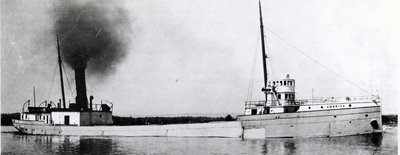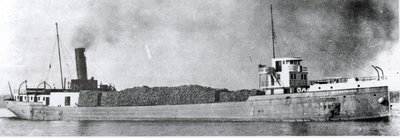Table of Contents
| Title Page | |
| Meetings | |
| The Editor's Notebook | |
| HERBERT G. FRANK, JR. | |
| Marine News | |
|
Ship of the Month No. 130 GLENSTRIVEN | |
| A History of the Port of Rochester by Ronald A. LaDue | |
| Table of Illustrations |
It is always difficult for us to select a Ship of the Month to feature in "Scanner". There are so many vessels about which we could write, but without the assistance of our members, it is a problem for us to know which ships might be of interest to them. Several members have written to ask that we feature the old Playfair steamer GLENSTRIVEN, and it gives us pleasure to accommodate them at this time. We hope that all of our readers will find her story as interesting as do we.
GLENSTRIVEN was one of the early steel-hulled steamers on the lakes. She was a combination bulk carrier and package freighter, and was built in 1889 at Buffalo, New York, as Hull 48 of the Union Dry Dock Company. Launched on April 23, 1889, she was 274.7 feet in length, 42.2 feet in the beam, and 22.0 feet in depth, these dimensions giving her tonnage of 2171 Gross and 1748 Net. She was powered by a fore-and-aft compound engine with cylinders of 28 and 50 inches, and a stroke of 48 inches, which produced 700 indicated horsepower. AMERICA was the name given to her at her christening.
AMERICA was a handsome steamer. Her hull was graceful, blessed with the sweeping sheer that was typical of marine architecture of her day. Her lines were, however, disturbed by her full forecastle, whose head was cut parallel to the water rather than to the sheer of the deck, and this gave her the appearance of being down by the head. The bridge structure was set one hatch back from the forecastle (to which it was joined by a catwalk), and a closed rail extended down the spar deck as far as the after end of the forward cabin.
The base of the bridge structure was a large square texas cabin that sat on the spar deck. Above it was the pilothouse, a smaller cabin with a slightly rounded front. It had a door and one window on each side and four large windows across its front. On the monkey's island atop the pilothouse was the navigation bridge, which sported bridge wings for canalling and docking, and was surrounded by a dodger to protect those on watch from the weather. An awning could be stretched above the open bridge as protection against the sun.
Down the spar deck stretched an open rail on either side. It gave way to a closed steel rail around the after cabin. The after deckhouse was a rather "bald" structure, without much boat deck overhang, and at its forward end was a large square boilerhouse whose roof was raised slightly above the level of the boat deck. A well-proportioned stack rose from the boilerhouse, its stately rake matching that of the mainmast, which rose abaft the stack, and the foremast, which was stepped just behind the pilothouse and sprouted out of the texas roof.
AMERICA carried two anchors forward. Later, these consisted of a mushroom anchor on the starboard side and a regular stockless anchor to port, each being suspended from a hawsehole through which fed the chains. On the forecastle head on each side was a small davit, and these were originally used to drop and hoist the anchors as needed, the steamer at first having been fitted with two patent anchors with folding stocks that were carried up on deck. These were replaced when stockless anchors became fashionable, but the davits remained in place. AMERICA was originally painted black, while her forecastle and cabins were white. As far as we know, he stack was planted all black.
The steamer was enrolled at Buffalo as U.S.106638. Her original owners were M. M. Drake et al., who operated her in conjunction with the Lackawanna Railroad. In those days, the railroads were much involved in the shipping business, running many lake lines to connect with and even compete with the various rail lines that skirted the lakes. In 1893, the ownership of AMERICA was transferred to a syndicate headed by John Kelderhouse of Buffalo.
By 1899, G. W. Maytham et al., Buffalo, were listed as owners of AMERICA but it should be noted that Maytham had held an interest in the ship ever since her construction in 1889. By 1902, Charles Beyschlag of St. Clair, Michigan, was her owner, and he had her port of registry changed to Port Huron. Beyschlag sold AMERICA on June 6, 1905. to the Wisconsin Transportation Company, an affiliate of the C. Reiss Coal Company of Sheboygan, Wisconsin. The ship was transferred in 1912 to the North American Steamship Company, Cleveland, another Reiss affiliate. During her years of operation for the Reiss interests, AMERICA was used mainly in the coal trade, but her appearance was not significantly different from what it had been originally. Even her basic black and white colours remained virtually unchanged.
In 1916, AMERICA was sold to the Lake Transportation Company of Buffalo, which was managed by Boland and Cornelius. Almost immediately, however, she was resold to James Playfair's Great Lakes Transportation Company Ltd. of Midland, Ontario. Strangely enough, she was not officially placed in Canadian registry until 1919, at which time she was enrolled as C.138218 at Midland, and was renamed (b) GLENSTRIVEN, with her tonnage recalculated as 2152 Gross and 1585 Net. James Playfair regularly named his ships for locations in his native Scotland, but a check of the atlas fails to turn up any place specifically named Glenstriven. We suspect that she was named for the glen in which Loch Striven lies; it is located in the Strathclyde district of mid-Scotland, somewhat to the west of Greenock.

The year is 1918 and AMERICA, in Playfair colours, is downbound in Little Rapids Cut, Young photo.
Playfair usually employed GLENSTRIVEN in the grain trade, primarily operating her between the Canadian Lakehead and the ports of Georgian Bay, for she was slightly too large to transit the locks of the old Welland and St. Lawrence River canals. Nevertheless, she did carry other cargoes, such as coal and pulpwood. Both in her first few years as AMERICA under Playfair ownership, and later as GLENSTRIVEN, she was painted up with grey hull and deck rails, white forecastle and cabins, and a crimson stack with a wide, black smokeband.
During her Playfair years, GLENSTRIVEN received the only major changes in appearance of her career. By the time she joined the fleet as AMERICA, she had been given a rather flimsy wooden upper pilothouse, which was placed on the monkey's island, where the open bridge had earlier been located. Sometime after 1918, and perhaps about the time that she was renamed, her entire bridge structure was rebuilt. The lower section of the structure was retained, although it was considerably reduced in size. Above it was built a new texas, a tall square cabin with two sets of paired windows in its front. Above that again was constructed a new rounded pilothouse complete with a sunvisor and bridgewings. At about the same time, the steamer's heavy old pole masts were moved and replaced with light steel pipe spars.

Another Young photo taken at Little Rapids shows GLENSTRIVEN downbound with a cargo of pulpwood in the period 1919-1923.
Unfortunately, GLENSTRIVEN's career in Playfair colours was to be of short duration. Late in November, 1923, she loaded a cargo of 160,000 bushels of oats at Fort William for delivery to Midland. Autumn weather on the lakes can be particularly nasty, and so it proved on that final trip for GLENSTRIVEN. Once onto Lake Huron, she ran into heavy fog, and the vessel went off course whilst passing through the islands at the head of the Bruce Peninsula. At about 8:30 a.m. on Friday, November 16, she ran hard aground on South West Shoal off Cove Island, some five miles west of the town of Tobermory. GLENSTRIVEN was not equipped with wireless apparatus, but distress signals were sounded on her steam whistle, and they were answered by several local tugs which came to her assistance.
The efforts of the tugs, which tried to pull her off the shoal, were to no avail, for GLENSTRIVEN's hull was badly punctured and hopes of salvage were temporarily abandoned. The crew, with the exception of the master, Captain Dulette, and two mates and two engineers, was removed on Saturday, November 17. The rescue operation was performed with considerable difficulty, for a strong westerly gale had sprung up and the seas were running high. With lightering operations impossible, the crew was taken to Midland by the government tug MURRAY STEWART, while the master and his skeleton crew of officers remained aboard their stranded steamer to assist in removing anything of value.
The Reid Wrecking Company of Sarnia was soon on the scene, with Capt. Tom Reid passing through Wiarton on the evening of Thursday, November 22, en route to the wreck. Reid secured a contract to free the stranded GLENSTRIVEN and he called his tug SMITH and lighter MANISTIQUE to the scene in an effort to salvage the cargo of oats and haul the ship free of the shoal. Heavy weather hampered the salvage operations and GLENSTRIVEN was not refloated until Wednesday, December 5, 1923.
GLENSTRIVEN was taken to Tobermory for temporary repairs and was then towed around to Collingwood for drydocking and inspection. She still held most of her cargo, although some of the oats that had been removed by MANISTIQUE eventually wound up in the hands of local farmers. When GLENSTRIVEN was placed on the Collingwood drydock, it became apparent that the damage was so severe that repairs could not be completed economically. Accordingly, she was abandoned as a total loss and was broken up at Collingwood during 1924.
Thus ended the career of a handsome steamer that was only 35 years old at the time of her loss. It must be remembered that the need for upper lakers of her size was decreasing rapidly at the time, and it is unlikely that she would have lasted through the Great Depression even if she had survived the various ownership changes that were to affect the Playfair ships in the mid-1920s. Be that as it may, her stranding was unfortunate and her end untimely.
(Ed. Note: We are indebted to member Ron Beaupre for providing contemporary news reports concerning the stranding of GLENSTRIVEN and the subsequent salvage operations.)
Previous Next
Return to Home Port or Toronto Marine Historical Society's Scanner
Reproduced for the Web with the permission of the Toronto Marine Historical Society.